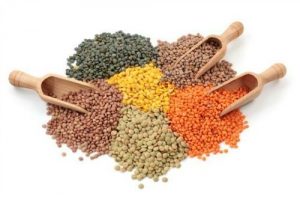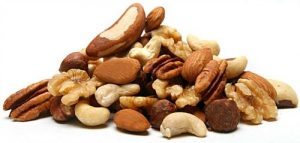Here Are the Top 10 Most Acidic Foods to Avoid
Are your food choices helping your body achieve a perfect balance that keeps you feeling healthy and energized?
Chances are, if you’re like most of us eating a modern diet, the balance in your food choices – between acid and alkaline foods – has flipped to just the opposite of what your body needs.
One of the key ways to test your body’s balance is to measure your blood pH.
In this post I’m going to lay out the role your blood pH plays in promoting health, and which foods might not be the most helpful for you when it comes to eating for energy and overall vitality.
You might be surprised by some of the foods on the acidic list.
Acid, Alkaline, and Neutral Blood pH
Let’s get into some background first about your blood pH. First, it’s measured on a scale of 1-14, which ranges from highly acidic to highly alkaline.
Stomach acid, for example, has a pH of 3.5, because your stomach must be highly acidic to break down food and kill of harmful pathogens and bacteria.
Ideally, our blood pH should be between 7.35-7.45, which is considered neutral. Anything less than 6 is highly acidic, while anything over 8 is more on the alkaline side.
Keeping a neutral blood pH is critical for a number of reasons.
First, acidic blood prevents oxygen from reaching cells, which stops cells from functioning properly (1).
And when cells aren’t properly receiving oxygen, they can’t transport oxygen to your organs.
This directly impairs your body from being able to perform critical functions such as digestion and energy production.
[Get the Perfect Smoothie Printable: It’s the Easiest Way to Load Up on Alkalizing Foods]
High Acid Foods vs. Low Acid Foods
The types of foods we eat on a regular basis impact the acidity or alkalinity of our blood.
Like our blood, food can be measured on the pH scale as acid or alkaline. Now, it’s important to note that we need both to maintain a good pH balance.
But here’s the thing: most foods in today’s standard diet are on the acidic side of the scale.
So, instead of eating a combination of 80 percent alkaline foods and 20 percent acidic foods (which is optimal to maintain a neutral blood pH), the ratio has flipped to 80 percent acidic and 20 percent alkaline.
Yikes!
While you might think that a food’s taste is a clue to its pH, that’s not the case at all.
Instead, foods are considered acid foods or alkaline foods based on the residue they leave behind when metabolized.
Foods are also considered low acid (or alkaline) based on whether or not they require alkalizing minerals to be released from the body. These minerals act as a “buffer” for highly acidic foods, to help minimize their negative effect on the blood.
This explains why citrus fruits, tomatoes and onions are alkalizing, despite having acidifying properties before entering the body. They do not leave behind acidic residue or need to be buffered upon being metabolized.
How Acidic Foods Affect the Body
Acidifying foods contribute to lowering the blood’s pH.
Acidic blood can lead to serious health conditions, such as kidney stones, an increased risk for cancer (an acidic environment is favorable for the growth of cancer cells), and can also prevent the liver from being able to properly detoxify (2).
Bone density can also be reduced by acidic blood. This is because calcium, an alkaline mineral, is leached from the bones to neutralize the blood’s pH when it risks becoming too acidic (3).
Some people report stomachaches from eating acidic foods – but whether not acidifying foods cause stomachaches is subjective and depends on an individual’s internal environment and current state of health.
The stomach lining is naturally protected from acidity, as it would otherwise get “eaten” by stomach acid. But in some cases, people with digestive issues like acid reflux or stomach ulcers might be bothered by acidic foods.
Foods that aren’t considered acidic but that have acidifying properties before digestion can sometimes aggravate existing digestive issues as their acidity (not their pH) can be felt prior to digestion.
Acidic foods have also been linked to promoting canker sores. While there’s no current evidence that acidic foods are the primary cause of canker sores, it’s suggested they may trigger certain areas around the mouth where stress or tissue injury already exists.
Cravings for Acidic Foods
And to top it off, acidifying foods also have the potential to cause cravings for more acidic foods.
In most cases, the body becomes conditioned to crave the foods you eat most frequently. So, if your diet is high in acidifying foods, you are more likely to get cravings for them.
In some cases, cravings for acidifying foods could be the body’s way of asking for help in breaking down excess calcium, or to rebalance your pH if it’s become too alkaline (although it’s less common to encounter highly alkaline blood).
As you can see, it’s important to keep an eye on your intake of acid-forming foods, and make sure that alkaline foods form the basis of your diet to prevent health complications from acidosis.
Not all acidic foods have to be completely avoided, but eating them less frequently will help you maintain a healthy blood pH.
Here’s an in-depth list of acidic foods to minimize in your diet.
Top 10 Most Acidic Foods to Avoid
1. Meat
Animal protein – chicken, turkey, and beef – is considered acidic once metabolized.
This is because animal protein contains high amounts of purines, which are compounds present in RNA and DNA, and form uric acid. When high levels of uric acid build up in the blood, not only does it have an acidifying effect on blood pH, but uric acid can also spread to tissues and joints, causing gout and kidney stones.
As a less acidic alternative to animal protein, plant protein sources such as chlorella and spirulina contain a lower amount of purines.
If you do choose to include meat in your diet, I recommend sticking to organic and free-range animal products, which are typically higher in nutrients.
Wild game like bison or elk have less of an inflammatory effect, and a higher concentration of omega 3 essential fatty acids.
2. Dairy
Dairy falls under the umbrella of acidifying foods to avoid. This is because it has a dysfunctional mineral relationship.
As I’ve mentioned in previous blog posts, the importance of minerals to health is all dependent on how minerals work together in the body, which is why they are needed in specific ratios.
When considering cow’s milk, dairy products contain both calcium and phosphorus. Calcium and phosphorus are needed in the ratio of 2.5 to 1 for optimal health. Unfortunately, cow’s milk has a ratio of 1.27 to 1.
This means that while we certainly receive calcium from cow’s milk, we’re also receiving far too much phosphorus.
Phosphorus prevents the absorption of calcium in the small intestine, and the acidifying effects of milk requires calcium to be leached from the stores in bones to prevent blood from becoming too acidic.
Nut milks such as almond or coconut milk are less acidifying milk alternatives to dairy.
3. Grains
I personally recommend avoiding glutenous grains not only because they are difficult to digest and create inflammation in the body, but also because they’re acidifying (4).
Non-glutenous grains such as brown rice, quinoa, and buckwheat are still considered acid forming, but rank lower on the acidity scale. For this reason, they’re acceptable to include in your diet in small amounts, but shouldn’t be a staple at every meal.
Non-Glutenous Recipe Options:
- Vegetarian Quinoa Bibimbap Recipe
- Easy Mango, Quinoa and Black Bean Salad
- Vegan Buddha Bowl with Sweet Sesame Brittle
4. Legumes
Legumes are considered a mildly acidifying food, but they also come with several health benefits. For this reason, it’s not necessary to completely avoid legumes, but to eat them in moderation and pair them with alkalizing foods.
Legumes help balance blood sugar levels, which is a major health benefit when you’re eating for energy. They also have the ability to help lower blood pressure and LDL cholesterol levels (5).
In fact, I cover many health benefits of legumes in this blog post.
5. Eggs
Eggs also rank as acidic for being rich in uric-acid forming purines.
If you choose to eat eggs, try to limit your consumption or increase your daily intake of alkalizing foods.
As with meat, I also recommend going for quality when it comes to eggs and opting for an organic, cage-free variety, as they will be higher in nutrients and contain fewer antibiotics and hormones, which are toxic to the body.
6. Nuts
From an acid-alkaline perspective, nuts are a better source of protein than animal products since they’re less acidic when metabolized.
However, nuts are still mildly acid forming, so limiting their consumption to 20 percent or less of your overall diet is recommended.
7. Vegetable Oils
Vegetable fats and oils such as canola or sunflower seed oil have a mildly acidifying effect on the blood.
While their essential fatty acids are needed for good health, healthy fats aren’t required in high amounts. This is why limiting the healthy fats in your diet to 20 percent (included with nuts) is an ideal amount to have less of an impact on blood pH.
8. Alcohol
Alcohol is a highly acidifying food that, when metabolized, robs the body of alkalizing minerals such as magnesium.
Alcohol can also aggravate stomach aches in those whose digestive systems are sensitive to highly acidic foods.
9. Coffee
Coffee is considered highly acidic because it also requires the release of minerals from the body to be buffered when metabolized.
All forms of coffee is acidic, but some are more acid forming than others, depending on how the beans are roasted and brewed.
If you’re a frequent coffee drinker, I recommend sticking to swiss water decaf as its overall acidity content is lower, and it does not use chemicals to be processed.
10. Refined Sugar
White or refined sugar – which includes soda, muffins, pastries, candy, white bread and processed grains and other “leisurely” foods – is highly acid forming.
One of the reasons why many people develop a higher blood pH is because processed foods that contain several grams of refined sugar are prevalent in our diets as convenience foods.
Some people include sugary processed foods at every snack and meal. You can only imagine how much work your body has to do in order to neutralize the acidity of refined sugar.
[Related: Sugar Detox Plan: A 10-Step Blueprint for Quitting Sugar]
If you have a sweet tooth, you’re much better off to get your sugar fix by eating alkalizing fruit and vegetables, such as sweet potatoes.
Raw honey, dates and maple syrup are alkalizing alternatives to acidic sweeteners that can be consumed in small amounts.
Tipping the Balance
As you may have already guessed, the best way to neutralize the negative effects of acidic foods is to eat plenty of alkaline foods – and the most alkaline foods and vegetables and fruits.
Eating plenty of vegetables helps provide your body with the essential vitamins and minerals required for health that are used as buffers against acid forming foods.
By focusing on eating alkalizing foods and cutting back on acid-forming foods wherever possible, you’ll be doing your body a massive favor.
















